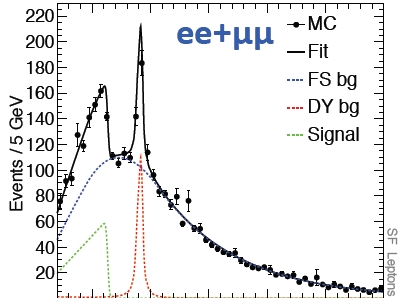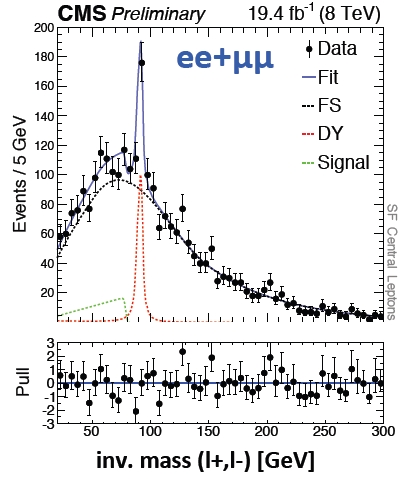I would have no problem letting them wait for late 2015, when the first inverse femtobarns of 13 TeV collisions will have been given a look at. But another thing happened today which made me change my mind - a colleague noted in the comments thread of that article that the LHC experiments appear to not publish their 2- and 3-sigma excesses when they see them, waiting for more data that "wipes out" the fluctuation. This is a strong (and probably unsupported) claim!
So I decided to make the SUSY enthusiasts happy today, by posting here a hot-off-the-press 2.6-standard-deviations effect produced by a CMS search for an "edge" in dilepton events. What is an edge, you might well ask first of all. Reasonable question, so let me try and explain.
The production of supersymmetric particles in proton-proton collisions is expected to occur in pairs, and each of the two bodies is usually believed to produce a chain of decays whereby a standard model particle is emitted and the SUSY particle turns into a lighter one still belonging to the supersymmetric world, thereby conserving a quantity characterizing the supersymmetric particles. At the end of the chain, one usually finds a neutralino - a stable particle which escapes the detector unseen, leaving behind a signature of missing energy, an energy imbalance in the plane transverse to the beams direction, in addition to all the other produced particles.
Now, depending on the mass hierarchy of the SUSY particles, the chain of decays may result in the observation of charged leptons and missing energy; signatures involving electrons and muons are especially useful as they are rather free of nasty backgrounds from strongly-interacting particles. If one computes the invariant mass of pairs of leptons observed in an event, and the event is due to a chain decay of SUSY particles, the two leptons may exhibit a mass which distributes not as a Gaussian (as one would expect for a normal resonance), but rather a funny shape having a sharp edge at the maximum value.
The reason for the funny shape is that the two leptons do not come from the same particle decay; they come from the subsequent decay of two different SUSY particles. Hence their invariant mass can have any value, up to a maximum - they cannot exceed the mass difference between the two SUSY bodies. So for instance if particle X goes to an electron and thus turns into Y, and Y subsequently emits a muon and becomes Z, the mass difference X-Z is the maximum that the electron-muon pair can make.
A clean edge in the mass of lepton pairs would be a very striking signature of a SUSY particle decay chain. So CMS looked for a hint of such a structure in their data. The analysis is now public and you can see the money plot below. It is the invariant mass distribution of pairs of electrons or pairs of muons in events selected as potential signal candidates with some jet and missing energy requirements. The blue curve describes one background component, the red one is the Z->dilepton peak and continuum background, and the green curve is the signal shape, which has a typical triangular structure.

Striking, huh?
Aha! No, unfortunately I am kidding - the plot above is a Monte Carlo simulation of what the data would look like if there was a SUSY signal there! Otherwise, I would not be using mild tones in this post; I would be screaming that we have finally made the discovery of the century! No. The real CMS data is shown below.

As you can see, on top of the expected background distribution one could see a smallish triangular-shaped excess at low invariant masses. Its significance can be estimated as a 2.6 sigma effect. Of course, as I explained in the previous post (and I am not doing it again here), there is no room for excitement; but it is still encouraging for those of you who strongly believe that some SUSY signal will eventually be found at the LHC. Who knows - this might grow to 5 sigma next year...
If you need more information about the analysis, you can find it in the slides shown yesterday by Kostas Theofilatos from ETH Zurich, or at this link. Enjoy it, Sven! (to others: Sven is the commenter of the previous post who lamented that we do not publish 2- and 3-sigma effects often enough).




Comments